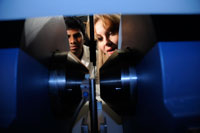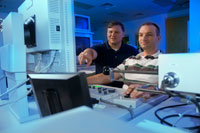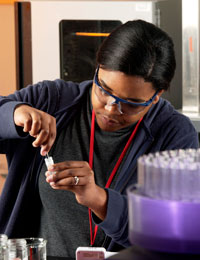 The term ‘research and development,’ or more commonly, ‘R&D,’ refers to “creative work undertaken on a systematic basis in order to increase the stock of knowledge, including knowledge of man, culture and society, and the use of this stock of knowledge to devise new applications,” according to the Organization for Economic Co-operation and Development (OECD).
The term ‘research and development,’ or more commonly, ‘R&D,’ refers to “creative work undertaken on a systematic basis in order to increase the stock of knowledge, including knowledge of man, culture and society, and the use of this stock of knowledge to devise new applications,” according to the Organization for Economic Co-operation and Development (OECD).
However, in the context of business, it typically refers to future-oriented, longer-term science and technology research – where forecasts of commercial yield are painted in broad strokes, rather than exact calculations.
A Big-picture View of Research and Development
Research and development is vital to the establishment and success of most businesses, especially those whose products or services rely on technology. It has economic significance beyond simply fostering scientific and technological development. It also reflects the willingness of a region, organization or government to focus resources on future performance and returns, rather than on today’s bottom line.
In 2006, the United States was among the world’s four largest spenders of R&D, along with the European Union, China and Japan. The U.S. spent $343 billion in R&D, which is 2.62 percent of its gross domestic product (GDP).
Typically, R&D is conducted by specialized centers belonging to companies, universities and state agencies – or some combination of the three.
Site Selection Factors that Support R&D
 The growth and development of R&D in regions around the country usually stem synergistically from several influences: the area’s economic strengths, the push of economic development professionals, natural resources, governmental assistance and often, ties to higher education.
The growth and development of R&D in regions around the country usually stem synergistically from several influences: the area’s economic strengths, the push of economic development professionals, natural resources, governmental assistance and often, ties to higher education.
For example, in eastern New Mexico, several notable research projects and businesses have grown out of the area’s abundant resources of sun, wind, wide-open land and underground water, as well as its firmly entrenched dairy industry that thrives because of those natural resources.
One business that is taking advantage of those resources is Roswell, New Mexico-based Berken Energy. The company has developed products that use thin-film technology that produces energy from both the sun and geothermal sources. Berken’s products are notable because they produce a significant amount more energy than conventional technology, such as solar panels.
One reason the company was attracted to Roswell was the area’s approximate 320 days of sunshine per year. Other reasons, according to Bob Donnell, executive director of the Roswell-Chaves County (New Mexico) Economic Development Corporation (EDC), were:
1. Proximity to Eastern New Mexico University
2. Infrastructure, which in this case is airline access via American Airlines – which began due to a regional cooperative, along with lobbying by the Chaves County EDC, no small feat for a city of only 50,000 people
3. Available property and lucrative rental rates
4. The support of the EDC and the community to support them through the start-up phase.
While Berken Energy is just one example, R&D-driven businesses around the country are drawn to a specific area by a similar mix of natural resources, complementary economic incentives and proximity to resources.
Jay Garner, CEcD, CCE, president of Garner Economics concurred, saying, “Based on our company's experience as site location consultants and in conversations with other companies, we see a constant, reoccurring set of criteria that drives the location process for biotech R&D facilities.” These include:
A skilled labor pool
Quality of life in the area, which will help attract and retain talent
Access to venture capital, which is especially crucial given the long time horizon of most research
Overall business costs, including labor, utilities and taxes
A culture of innovation and presence of higher education
A clustering of other biotech R&D facilities.
Clusters Drive R&D – and Development of Businesses
Clustering is crucial to building a thriving research and development region. As the number of complementary businesses and related research grows in an area, the region’s draw increases exponentially.
Gene Simmons, director of the Small Business Development Center at Eastern New Mexico University, Roswell, explained the concept of clustering by saying, “If the overall environment is complementary of the research, the research then aligns with the industries. This, in turn, becomes a cluster.”
From an economic development and multiplier perspective, clustering is also a good thing. Simmons cited the example of Leprino Foods, a Roswell, New Mexico company that is one of the nation’s largest producers of cheese. For every dollar that Leprino spends, $5.80 stays in the community. This high number stems from the cluster of complementary businesses, from the dairy farms and the alfalfa farms that feed the cows to an in-the-works energy company that has plans to turn cow manure into biomass fuel. This is in contrast to a standalone business, such as a bowling center, that only puts an average of $1.38 per dollar back into the economy.
Academia is a Major Generator of R&D
 Access to higher education is another huge driver of companies reliant on R&D. The Bayh-Dole act, which was enacted 27years ago, set the stage for close ties between university-funded research and business. The act lets universities patent and commercialize inventions that come from federally funded research. It has gradually turned universities into incubators for breakthroughs in technology and medicine. One beneficiary, for example, is Stanford University, which owns the patent on Google’s Internet search technology. Last year alone, the university earned $48 million from 428 technologies licensed to companies.
Access to higher education is another huge driver of companies reliant on R&D. The Bayh-Dole act, which was enacted 27years ago, set the stage for close ties between university-funded research and business. The act lets universities patent and commercialize inventions that come from federally funded research. It has gradually turned universities into incubators for breakthroughs in technology and medicine. One beneficiary, for example, is Stanford University, which owns the patent on Google’s Internet search technology. Last year alone, the university earned $48 million from 428 technologies licensed to companies.
One university that has spawned groundbreaking technology – and companies based on that research – is Louisiana Tech University, in Ruston, Louisiana. This medium-sized, public university was one of the first in the nation to offer a biomedical engineering program in the early 1970s, due in part to its visionary president who is a chemical engineer by training.
“The Enterprise Campus at Louisiana Tech was created to build strong research partnerships with the private sector,” said Leslie Guice, PhD, vice president for Research and Development at Louisiana Tech. “It provides research synergies between tenant companies and faculty, and accelerates technology transfer through collaborations with those who are most effective at commercializing technologies.”
Artificial Cell Technologies (ACT), in New Haven, is an example of a company with close ties to the university. The company has commercialized applications of multilayer polypeptide nanofilm technology, which was developed at Louisiana Tech in 2001. ACT is using that technology to create artificial cells to develop artificial virus synthetic vaccines against diseases that are difficult to protect against, such as dengue fever. ACT has exclusively licensed this technology from Louisiana Tech University.
Another example is Brain Vital, a company based in Cambridge, Massachusetts and Baton Rouge, Louisiana. Brain Vital uses technology developed by Louisiana Tech faculty to detect the onset of epileptic seizures and terminate them before a person is harmed.
Guice noted that both companies are funded by sizable private venture capital.
Because of the region’s strength in biomedical and technology-related research, other organizations have sprung up in the area, including the Biomedical Research Foundation of Northwest Louisiana (BRF). BRF is an independent organization that includes the InterTech Science Park for life science and related technologies, Positron Emission Tomography (PET) Imaging Center and Southern Isotopes and also supports the Louisiana State University Health Sciences Center in Shreveport. Another is the Cyber Innovation Center, a public/private partnership in Bossier City, Louisiana that focuses on cyber security.
Guice credits some of this to government incentives, including the state Research and Development Tax Credit and federal Small Business Innovative Research grants that encourage businesses to establish and sustain R&D. Another is Louisiana’s Angel Investor Tax credit that encourages investment in early-stage wealth-creating businesses.
University Research Centers Tie R&D to Their Area’s Assets
Supporting the concept of clustering, the R&D centers of research-driven universities often concentrate on areas that tie into their region’s assets. The research coming out of the university then fuels the development of new businesses, which further tightens the region’s grip on those areas.
This holds true at the Ohio Agricultural Research and Development Center (OARDC), which is part of Ohio State University with a reputation as one of the leading agricultural science centers in the country. The OARDC focuses primarily on bioenergy and biobased products, environmental quality and sustainability, along with food security, production and human health.
Based in central Ohio, the OARDC is surrounded by agriculture and food processors. The region is also home to cluster companies such as Scotts Miracle-Gro and the J.M. Smucker Co.
Rod Crider, president of the Wayne (county) Economic Development Council said, “The OARDC is a huge generator of economic activity in our area.”
Crider also noted that the Battelle Memorial Institute, an international science and technology enterprise, found that the OARDC has a $1 billion economic impact in both the area and the country.
OARDC is developing the BioHio Research Park, which will be located on its Wooster campus. As the first business and technology center in Ohio, it is aimed at capitalizing on the enormous potential of the agricultural biosciences and transforming it into new commercial ventures and jobs. BioHio has already led to collaborations with Cleveland-based Quasar Energy Group, which has a laboratory and engineering facility at the OARDC.
Quasar has created a system that recycles energy from organic wastes that would typically be incinerated or hauled to landfills. Its technology solves waste management issues facing agricultural farmers, industrial food companies, municipal treatment plants and ethanol producers throughout North America. The resulting biogas can be turned into natural gas and the remaining liquid and solids can be used for fertilizer and soil amendments.
Jim Currie, program director at the OARDC, discussed how universities are focusing on technology transfer to foster the growth of companies like Quasar.
“We’re constantly looking at our assets, such as our knowledge, equipment and human capital, both scientists and students,” he said. “Then, we figure out how to connect them better to the public and private marketplace. At the same time, we’re talking with companies to see if they have a need that we can fulfill, which is what happened with Quasar.”
Personal Factors can also Drive a R&D-based Enterprise
While an organization’s development and site selection is based on rational business decisions, sometimes, the drive for success has highly personal roots.
Pecos Valley Biomass is a Roswell, New Mexico-based cooperative of 25 dairies. It is putting together methane digesters that will convert biomass – the area’s abundant cow manure –into energy, ultimately electricity and natural gas.
One of the drivers is New Mexico Governor Bill Richardson’s support of green technology. Clearly, another factor is the numerous dairies in the region that support cheese-giant Leprino Foods. But at a most basic level, the Pecos Valley Biomass’ $60 million-dollar project stems from the area’s dairy owners’ desire to be able to pass their dairies onto their children.
Gerry Greathouse, president and project manager of the Pecos Valley Biomass Coop said, “If we, the dairies, are going to stay in business, we need to come up with ways to better dispose of the manure. Right now, we’re running out of land to apply it.”
Like dairy producers nationwide, they are feeling the pressure of environmental regulations and groundwater concerns. Greathouse said that Pecos Valley Biomass is trying to create a zero-discharge, closed-loop biomass system. The venture is viable, in part, because of the high concentration of dairies in the area, as well as the nearly 100,000 cows. A central pipeline will connect the 25 dairies to transport waste to a central digester.
Financing and technology for the plant is coming from a combination of private and public sources, along with government grants and tax credits.
R&D’s Huge Impact – Locally and Nationally – Drives Growth and Makes the World a Better Place
Whether its application is saving lives or saving the environment, research and development is thriving throughout the United States. Spurred on by higher education, the federal government and highly driven local economic development officials, companies are thriving and breaking new ground because of R&D.

